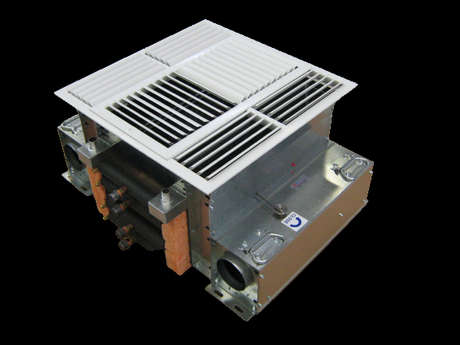The most typical solutions for decentralized air conditioning equipment in business buildings are ceiling induction units. They’re mounted beneath the suspended ceilings to coincide with the heating and cooling demands. This blog gives an idea about the different types of ceiling induction units used for commercial building cooling.
Ceiling Induction Units
Induction units, which are directly connected to the air duct system, allow air to flow through nozzles throughout the whole space. The temperature of the air is set in the heat exchanger, and the primary air is resupplied into the rooms through the air output grille. Traditional induction units do not have a local fan, but they do require high pressure from central AHU systems, which consumes more energy than low-pressure alternatives.
Induction Unit for Suspended Ceiling
The induction unit comes in a variety of sizes to best accommodate any retrofit application and size. It may be tailored to fit any space. With a drain pan, it’s possible to install it on the floor or the suspended ceiling. The induction units are available with a high induction ratio, low noise, and high capacity.
The following are the main benefits:
- Because induced room air is used instead of all-air, it requires fewer interstitial spaces than an all-air system.
- There are no additional maintenance or power requirements for local fans.
- Custom architectural enclosures are available in a variety of configurations.
Important considerations:
In humid locations, induction units must be used with caution due to the necessity to keep the cooling coils dry (there is no condensation collection system
Chilled beams:
Chilled beams, often referred to as active cooling beams, are connected to the main air distribution system for externally treated air. The primary air is forced under pressure through nozzles, where the ejection effect captures and sucks in the room’s secondary air.
The secondary air is sucked out of the room through a heat exchanger, which cools or heats the air. Inside the unit, the primary and secondary air are mixed, and then combined air is distributed to the room. Inside the Chilled beam, this “induction” takes place.
 Benefits of Chilled Beam
Benefits of Chilled Beam

- Designed specifically for high cooling and heating outputs
- There is no fan in this room because it is comfortable.
- The operation is completely silent.
- It’s ideal for use on a ceiling.
- It has a changeable functional configuration and does not reduce the useable space.
- The unit’s low installation height is ideal for new building and remodelling projects.
- Adjustable slats help to improve airflow.
- You do not need an energy supply.
- Minimum upkeep requirements
- Operating costs are low.
- Custom designs are available based on the needs of the customer.
Disadvantages of Chilled Beam
- Water leakage danger
- Prevent moisture and condensation.
- The cost of installation is high.
- The heating capacity is limited.
Ceiling Mounted Induction Unit (CM Induction Unit)
Ceiling Mounted Induction units are ideal for covert active chilled beam applications with a return air plenum in the ceiling void. They provide efficient, effective, and whisper-silent air cooling for practically any perimeter zone application at low static pressures.
CM Induction Terminal Units Have a Lot of Benefits
- You can save vacant space with CM induction units on HVAC new construction and renovation projects with compact dimensions and reduced duct size.
- The fan’s power has been reduced. The AHU treats the low primary air quantity and distributes it at low pressure. By using efficient induction technology, the air supplied by CM Induction Terminal Units is typically just 30% of the total air delivered.
- No fan energy is required since secondary air is induced across the secondary heat exchanger, producing localized cooling.
- The CM Induction Units are designed for ‘Lay-In’ installation in T-Bar ceiling tile systems or plasterboard ceilings with continuous grilles from builders.
- Most traditional induction units operate at higher primary air pressures than CM Induction Units.
- It provides more cooling capacity with less treated air than any other all-air system.
- The CM Induction Units provide two-stage capacity management by controlling secondary water flow and primary airflow.
- The noise produced by the CM Induction Units is extremely low.
- It has no moving parts.
Conclusion:
Now that you know about the induction units, their working, and their advantages and drawbacks, you can always opt for the best-suited chilled beams and induction units for ceilings for your residential and commercial buildings that fulfill your needs within the budget. As there are various induction units available in the market, there is always one that suits your requirements.
